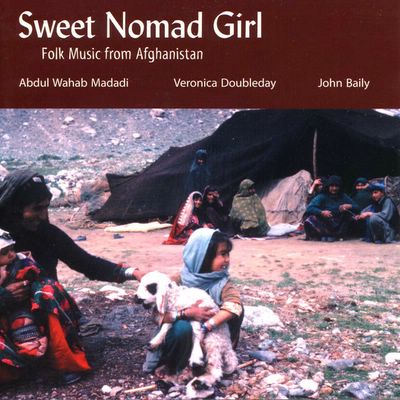
(CD cover, photograph by Veronica Doubleday)
Saudi Gazette
22 March 2005
The Other Side of Afghanistan
by Susannah Tarbush
Afghanistan has for decades been associated in the West mainly with images of endless upheaval and bloodshed. But a CD newly released in Britain, on the Metier World label, shows that Afghanistan is also a country of some of the most romantic and tender folk music to be found anywhere.
This is reflected in the title of the CDs: “Sweet Nomad Girl”. The cover photograph depicts a smiling young girl holding a lamb in an encampment of nomad women.
One verse of the song goes: “Shirin, sweet nomad girl/By the sequinned shawl she wears/She’s the beauty of the mountains/May God protect her.”
The song is performed by one of Afghanistan’s best-known singers, Abdul Wahab Madadi, who was born in Herat in the west of the country and worked for over 30 years at Radio Afghanistan.
Madadi left the country in 1992 and now lives in Germany. After the Taliban were ousted from Kabul in 2001, his patriotic song “Watan” was the first piece of music to be broadcast on Radio Afghanistan after five years of musical silence.
As well as being a performer, Madadi is a scholar who has studied and collected music. While at Radio Afghanistan, where he eventually became head of music of radio and television, he collected many Herati folk songs for the station.
Madadi first heard “Sweet Nomad Girl” when it was sung by Zainab Herawi when he was collecting traditional material in the 1970s. She had learnt it in the village where her mother was born.
Another song from the Herat area is “Tangerine Dress” which Madadi was the first person to record on radio and which he sang for the Shah on an official visit to Tehran in 1962.
The poetry of the song is by Herati poet Abdul Hossein Taufiq. The girl in the tangerine-coloured dress has offended the poet, and his cheeks are yellow with love-sickness (tangerines are yellowish in Afghanistan). “Tangerine dress, tangerine cheeks/I left the town of Morghab because of the tangerine girl’s cruelty.”
The CD was recorded in England last August. Five tracks were recorded at a music festival in the village of Semley, Wiltshire, when Madadi performed with Professor of Ethnomusicology at Goldsmiths College, University of London, John Baily and his wife Veronica Doubleday, who sings and plays the daireh frame drum. The other seven tracks were recorded at the church of St Mary in the West Sussex village of Barcombe.
As well as being a delightful assembly of folk songs, the CD is a record of the way in which the traditional Herati long-necked lute the dutar has evolved. The name means “two strings” and traditionally the dutar was played mainly by rural amateur musicians. The first innovation was the development of a three-stringed form, and then in the 1960s a much larger 14-stringed instrument appeared with sympathetic strings that vibrate and amplify the sound. This 14-string version is typical of professional urban musicians.
On the CD Baily plays each of these three types of dutar, and also demonstrates the different effect when the two-stringed version has nylon strings and when it has steel strings.
The tracks include “White Tents” a nomad song about a bride at a wedding, the love song “Rose without thorns”, the famous love song “Siahmu wa Jalali” and the well-known instrumental dance “Shishkebab” which comes from Turkey. When the music stops at different points in the piece, the solo dancer freezes in a stylish pose.

